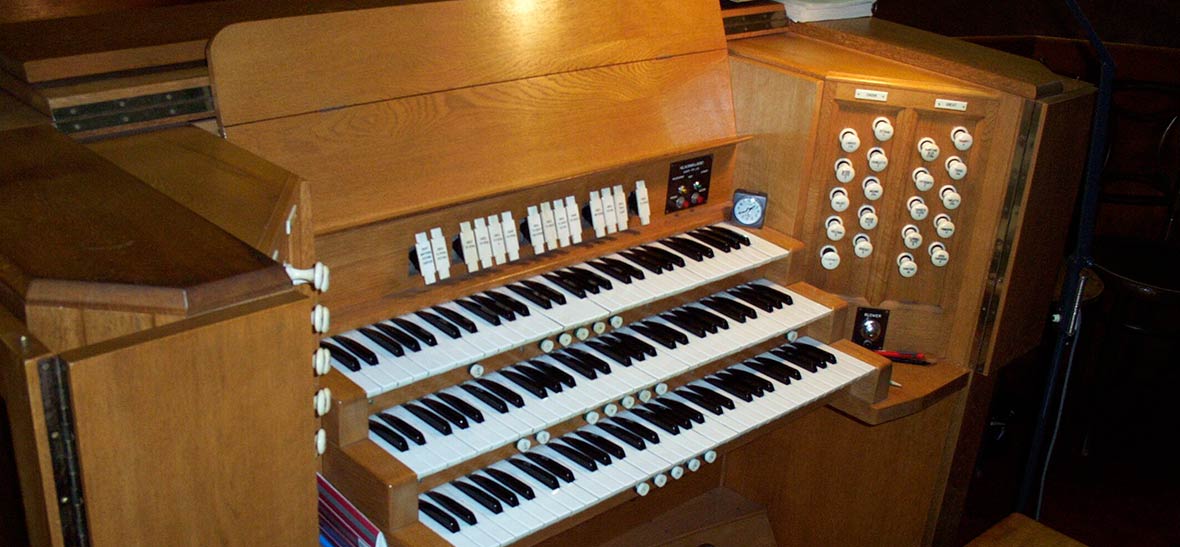
The Organ
The historic organ was built and installed in the church for its opening in 1889 by the Melbourne firm of Fincham and Hobday. George Fincham (1828-1910) was born in London, and served his apprenticeship under Henry Bevington, some of whose organs are also in Australia. Arthur Hobday was apprenticed to, and later a partner of, “grandfather” George Fincham.
The organ originally had two manuals and 20 stops and has been enlarged three times. In 1922, additions to the organ were carried out by J W Slatterie, an apprentice to George Fincham, who had started his own organ works in Melbourne. Most recently, in 1967, the size of the organ was increased to three manuals, 38 stops and about 1700 pipes by Hill, Norman and Beard.
The organ in its present form therefore represents hundreds of years of English and Australian organ building tradition, and is a fine example of Victorian craftsmanship. It is one of the larger Fincham organs of the late 19th century still in its original location in Melbourne. The case was designed by the church’s architect, Alfred Dunn, rather than the organ builder.
The 1967 Re-building
By 1967, the organ was showing its age. The pipework and soundboards had been untouched for 78 years, and the action for 75 years. The Trustees commissioned Messrs Hill, Norman and Beard (Australia) (which had been established in 1928 to erect the Melbourne Town Hall organ) to undertake the work (HN&B Order No V693). The specification was drawn up by Mr Michael Davies in consultation with the then Organist, Mr Brian Krahnert. Under that contract, the action was completely renewed, changing from tubular pneumatic to electro-magnetic, and major re-voicing was undertaken. The 8' Cornopean was placed on a new unit chest in the enlarged Swell box, enabling this rank to be used also as a 16' rank to tenor C, provision being made for the later installation of the lowest 12 pipes, to complete a full 16' reed rank on both the Swell and Pedal organs.
A new Swell mixture (22, 26, 29) was made possible by the gift of Mrs A J Dangerfield in memory of her husband. The former Clarinet was re-voiced and transposed to form a 4' Krumhorn. A new Choir/Positive department, based on two ranks moved from the Great and Swell, was made possible by the gift of the Woodhouse family in memory of John and Katharine Woodhouse. The Pedal department was also extended and balanced.
Subsequent Additions
In 1990, the Clarinet, formerly in the Swell box as a 4' Krumhorn, was removed, refurbished and placed on its own chest in the Choir/Positive department, the gift of Mrs Winsome Cousins in memory of Miss Winsome Clucas. The removal of the Clarinet from its slide in the Swell organ then made room for a new 4' Clarion, voiced to match the Cornopean, and this was added with funds provided by an anonymous donor.
By 2002, the Organ, while in good condition for its age, was in need of thorough cleaning and fine tuning. At the same time, it was considered desirable to complete the missing pipes from the 16' reed. A donation was received from the Danks Trust for the 12 new pipes, and this work was completed during 2003. For cost reasons, the cleaning was spread over two years, with the Swell department being dismantled and cleaned in 2003, and the Great, Pedal and Choir/Positive departments in 2004.
In 2002, a VESDA [Very Early Smoke Detection Apparatus] fire protection system was installed in the organ chamber and blower room. This is connected to the Fire Brigade’s automated despatch system, and should ensure that this organ does not suffer the fate of the old Melbourne Town Hall and St Kilda Town Hall organs.
Works Yet to be Carried Out
The facade pipes, originally stencilled in a brilliant design by Augusto Lorenzini, were painted a dull bronze colour in the 1930s. Purely by chance, copies of the original stencils were found recently in Sydney. A quotation has been obtained from Marc Nobel, who recently restored the stencilling to the facade pipes of St Paul’s Cathedral Organ, for similar work at Auburn, and the cost would be $35,000. The parish was unsuccessful in a submission for Centenary of Federation funding for this work, but further sources of funding are being investigated.
The combination pistons have now required substantial repair as a result of continuous usage. A new solid-state system, programmable by the player, will be considered as funds permit.
Specification of the Organ
Specification of Fincham & Hobday Organ, 1889 - 1922
Current Specification, 2003
The organ is in regular use and may be heard every Sunday morning between 10am and 11am and several times a year at concerts.
